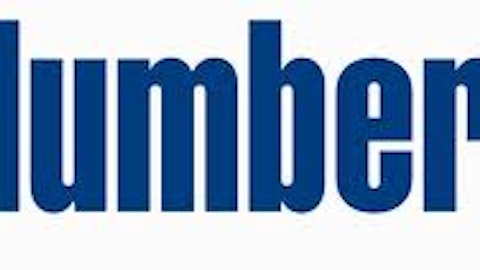In the dawn of a new age of in the energy and oil industries, while North American oil production has risen by 37% and natural-gas by 19%, where is the money for investors?
Obviously many investors think differently here, and there is no one straightforward answer, but one group of companies that won’t necessarily come up in your everyday conversation may help savvy investors decide where to put their money in this “new age.”

I’m talking about the three largest oil-field-service firms — Schlumberger Limited. (NYSE:SLB), Baker Hughes Incorporated (NYSE:BHI), and Halliburton Company (NYSE:HAL). Combined, the three companies have invested more than $2 billion in research and development for the future, but I’m going to use a couple of metrics and ratios to tell you which one I think is worth having in your portfolio.
First, let’s look at how much they each have invested in research and development over the past five years:

Source: Wall Street Journal
With such a large sum of cash being invested, there is so much promise for the industry. Let’s look at which firm is right for your portfolio:
Asset Utilization
Measuring a company’s asset utilization is one of my favorite metrics to use, and it is great way to measure the efficiency of a company. In determining which of these three companies may belong in your portfolio, there are obviously countless factors, and efficiency is one of many things to take into account. However, for the sake of analyzing the companies broadly, asset utilization is one of the ways I will be using.
Asset utilization calculates a company’s total revenue earned for each dollar of assets that the company owns. For example, a ratio of 70% means that the company earned $.70 for every dollar of assets that it holds. A higher percentage tends to indicate a higher efficiency with this ratio.
While it is not always pinpoint-accurate, the ratio does usually give us a good indication of how each company is in terms of efficiency. So, given that, let’s take a look at the graph:

As you can see, Halliburton Company (NYSE:HAL) is incredibly efficient according to this metric, with the other two companies close enough to each other to count the difference as nearly negligible. This means that Halliburton is a safe bet in terms of efficiency, which can be extremely important when picking stocks for the long run. Let’s look at our next ratio:
KZ Index
To me, this ratio is incredibly important for specific industries, and not as important for others. Obviously, I believe it is very important to the oil industry, and here is why: the KZ index measures how a company might fare should conditions “tighten” financially. More specifically, the KZ index, or Kaplan-Zingales index, measures, relatively, a company’s reliance on external financing to determine which companies may be more likely than others to experience difficulty financing ongoing operations should conditions worsen. In the oil industry in which prices and technologies are constantly changing, this is incredibly important.
The calculation of the ratio is incredibly long and complicated, so I left it to the computers to do it for me, but if you are interested in knowing the specifics behind calculating it, you can look here.
Let’s look at the chart:

For this ratio, a lower score represents a lesser probability of financial difficulty during tightened economic conditions.
Because all KZ scores are relative, a score of about -1 (about where Halliburton Company (NYSE:HAL) and Baker Hughes sit) is pretty good—in fact, it’s better than about two-thirds of companies out there. However, a score of about -4, or where Schlumberger Limited. (NYSE:SLB) is, is considered excellent, and is better than more than four-fifths of companies.
The index shows us that all three companies would most likely financially not encounter difficulties; however, Schlumberger Limited. (NYSE:SLB) has a large advantage should things go awry.
Finally, let’s look at the third ratio I’ve chosen.
Tangible book value per share
Tangible book value per share, or TBVPS, is a measurement of the portion of tangible assets (all assets, with the exception of goodwill and items classified as “intangible” on a company’s balance sheet) attributable to each share of the company’s common stock. What this means is that it is helpful in establishing the valuation of a company, and whether or not it may be over or undervalued.
This is important because lots of company’s balance sheets can reflect asset valuations that are inflated by intangibles; yet, if a company were to go bankrupt, the tangible value of assets a company has would be what is left over after bankruptcy.
A simple way to put this would be that tangible book value answers the question, “as a shareholder, what would I receive if the company had to liquidate all of its assets?” By measuring this value per share, we create a ratio that measures valuation.
A TBVPS larger than the current price of the stock means that the stock could be potentially undervalued, whereas, obviously, a TBVPS smaller than the stock could mean that the stock is potentially overvalued. Formulaically, for those who are interested, TBVPS is equal to: (Tangible Book Value – Book Value of Preferred Stock) / Common Shares Outstanding. Now, let’s look at each company’s TBVPS in relation to their stock price.

As you can tell, all three are potentially undervalued. So, which could be the most undervalued? To do this, we can simply divide the TBVPS by the current stock price, where the lowest TBVPS/Price would represent the company potentially the most undervalued.
| TBVPS | Price | TBVPS/Price (valuation) | |
|---|---|---|---|
| Schlumberger | 11.26 | $79.40 | .142 |
| Baker Hughes | 23.47 | $47.96 | .489 |
| Halliburton | 14.71 | $41.90 | .351 |
So, according to this metric, Schlumberger would be the most potentially undervalued. However, the other two boast perfectly respectable TBVPS / Price ratios.
Foolish bottom line
Obviously, there is much more at stake than these three metrics, and no company should be added to a portfolio based on solely these three things. However, these should help as a guideline when deciding between companies in an industry. My hope here was to help introduce you to a few not-so-common ways to evaluate a company that are still very useful.
So, in the end, who won? Well, Schlumberger Limited. (NYSE:SLB) won two out of our three “contests,” putting them in the lead, with Halliburton Company (NYSE:HAL) winning the other and Baker Hughes unfortunately going home with nothing. That certainly isn’t a knock against Halliburton or Baker Hughes; they just didn’t come out on top with the criteria with which I evaluated the industry.
The article The Oil-Field-Service Industry, According to Three Key Ratios originally appeared on Fool.com and is written by Michael Nolan.
Copyright © 1995 – 2013 The Motley Fool, LLC. All rights reserved. The Motley Fool has a disclosure policy.

